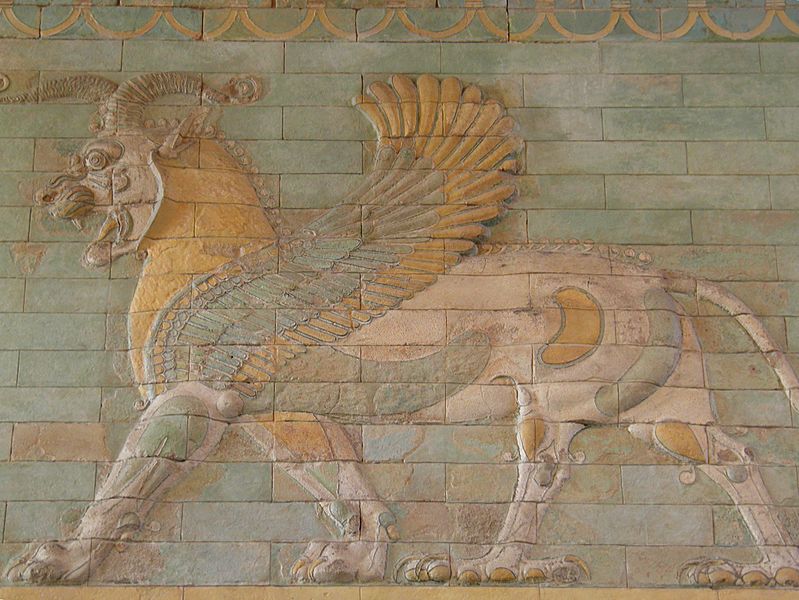Archivo: Frieze of Griffins, circa 510 BC, Apadana, west courtyard of the palace, Susa, Iran Susa, Iran, Louvre Museum (12251831946)

Descripción: The artists of the Achaemenian period inherited a pictorial vocabulary rich in mythological creatures. The griffin-lion, often represented at Susa, is here pictured on an element of architectural decoration from the palace of King Darius I the Great (522-486 BC). It featured here alongside the lion and the winged bull passant on reliefs made with bricks, with or without colors. A decorative motif The Frieze of Griffins is a reconstruction made with molded siliceous bricks coated in colored glazes, which had been reused in later constructions. During the excavations led by Jacques de Morgan at the Palace of Darius between 1908 and 1913 at Susa, thousands of these bricks and wall elements featuring animals and mythological creatures passant, lions, bulls and winged griffins were found. The bricks lined the walls as an architectural decor, and were charged with a symbolism relating to the Persian empire. A composite animal Set against a light-blue background, the white griffin passes toward the left under a frieze of palmettes. It has a lion's head, the ears of a bull, a roaring mouth and two curved goat horns, one pointing forward and the other backward. It has the body of a bull, the forelegs of a lion and hindlegs like the legs of an eagle, and its long tail is curled up into itself. The wings join the body at the top of the forelegs. Its breast and neck are covered with little curls that also run over the top of the back. The details of the animal are highlighted with a polychromy of yellow, blue and green. An ancient tradition The fabulous griffin figure evolved out of a long pictorial tradition of fantastic animals. On the Ishtar Gate of Babylon, there is a depiction of the Mushhushshu, a long-necked quadruped with the head and scaly body of a snake. This was the emblem of Marduk, war god and protector of the city. The griffin was a Susian creation of the late 4th millennium that became widespread, in many forms. An accounting tablet, for example, bears the mark of a cylinder seal showing a winged griffin followed by an antelope (Louvre Museum, sb4837). Many images of the griffin have been been found dating from the Neo-Elamite period, including one in bricks, shown passing before a tree, used as an element of architectural decoration (Louvre Museum, sb3370). Griffins facing each other also feature on the walls of the palace at Persepolis, built by Darius I, like the palace at Susa. The meaning of this imaginary animal remains unclear: it may refer to ancient Elamite religions and as such may represent an area of the Persian empire. Source: <a href="http://www.louvre.fr/en/oeuvre-notices/frieze-griffins" rel="nofollow">www.louvre.fr/en/oeuvre-notices/frieze-griffins</a>
Título: Frieze of Griffins, circa 510 BC, Apadana, west courtyard of the palace, Susa, Iran Susa, Iran, Louvre Museum (12251831946)
Créditos: Flickr
Autor(a): Following Hadrian
Términos de Uso: Creative Commons Attribution-Share Alike 2.0
Licencia: CC BY-SA 2.0
Enlace de Licencia: https://creativecommons.org/licenses/by-sa/2.0
¿Se exige la atribución?: Sí
Usos del archivo
La siguiente página enlaza a este archivo:

